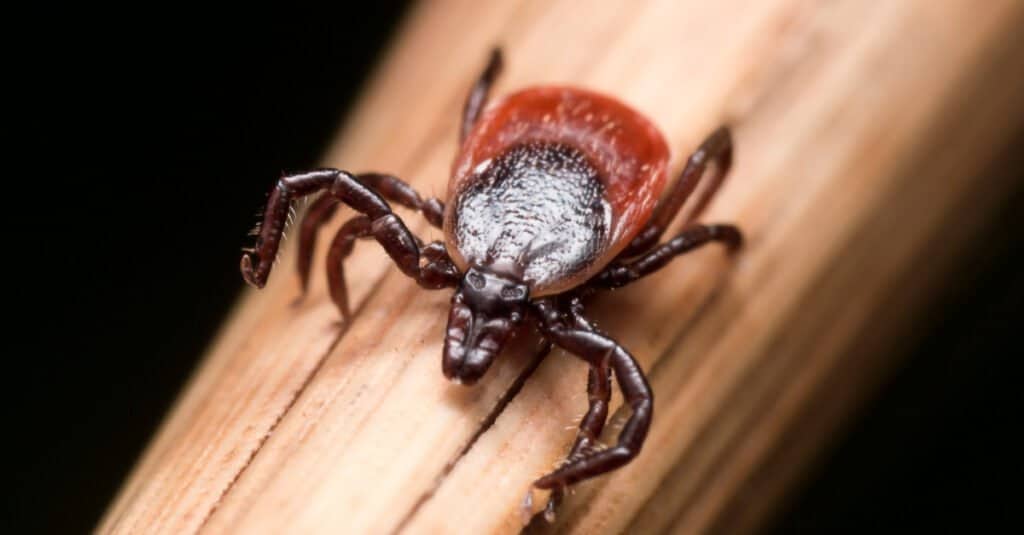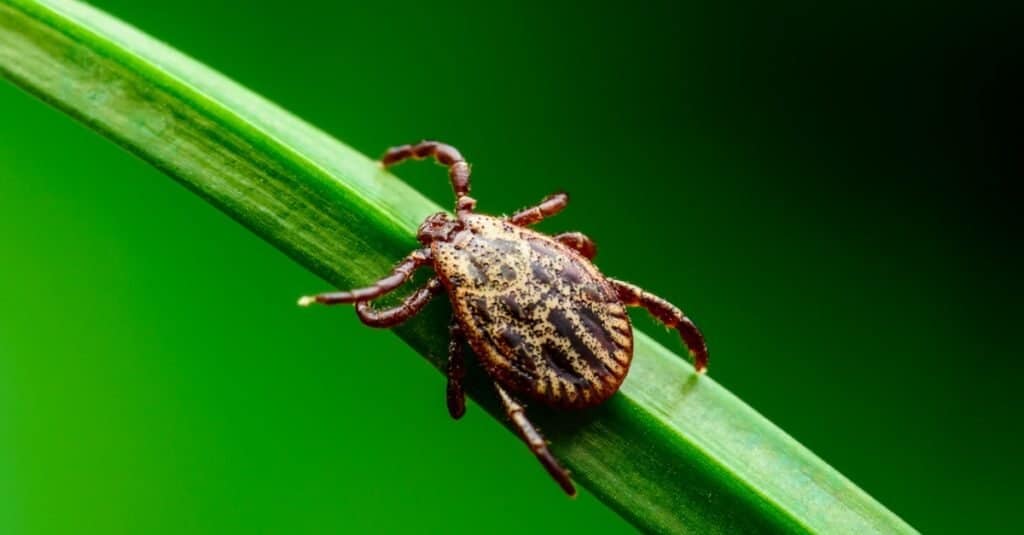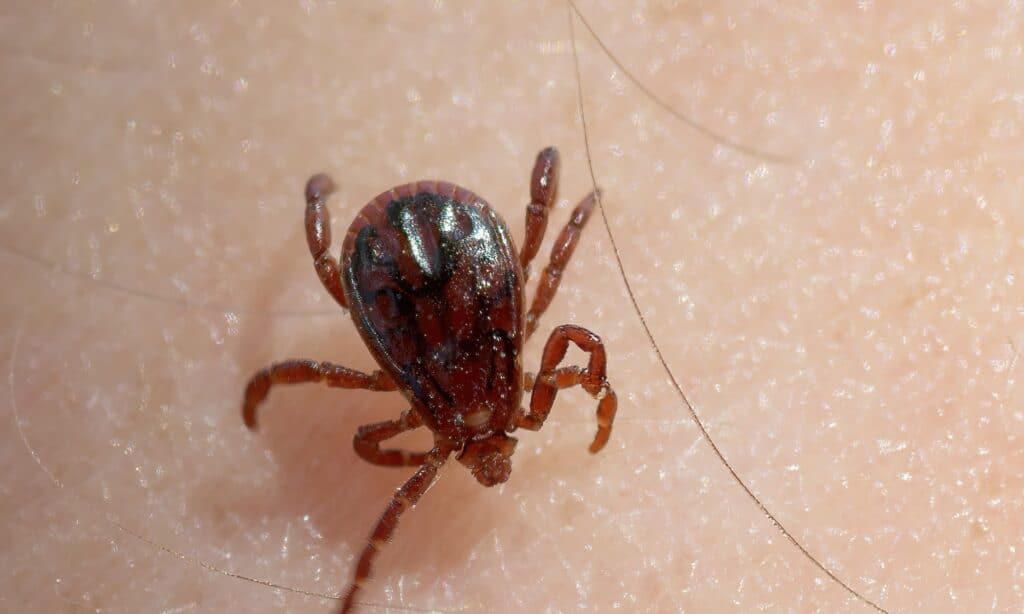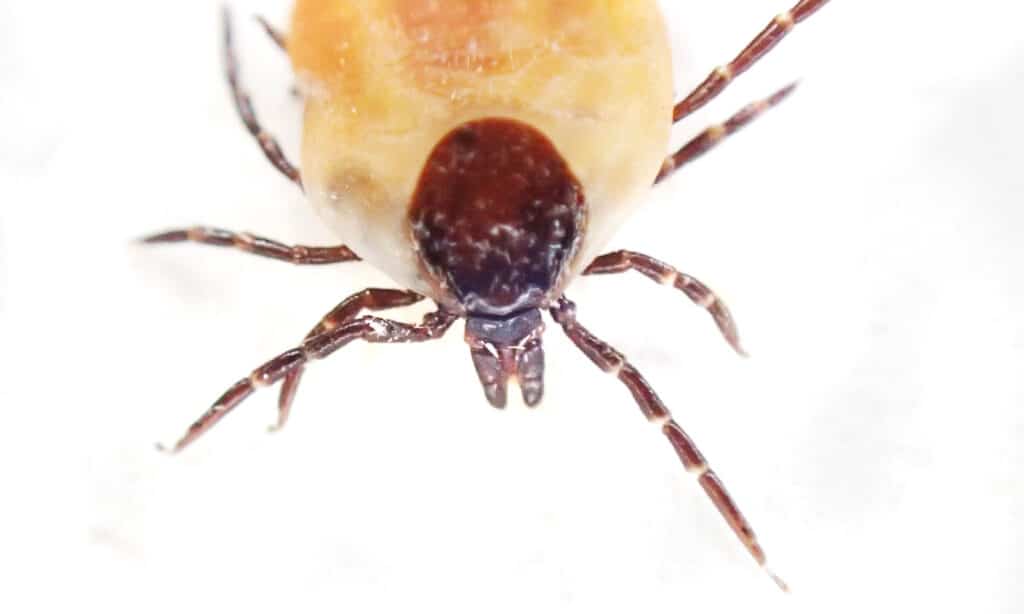Ticks are the number one cause of insect-induced disease in Arkansas, but not all ticks carry diseases. What makes ticks a vector for diseases is that in their early stages, nymphs and larvae generally feed on rodent populations.
Rodents, like mice and rats, are known harbingers of diseases in humans. When a tick consumes the blood of an infected rodent and then bites a human, the blood of the rodent can mix with the blood of the human. That’s how the disease is spread.
June through August are the most common months to be bitten by a tick in Arkansas. That’s because outdoor recreation is at its highest during the summer.
When a tick infestation happens, it’s usually not only one species of tick that takes hold of its host. What ticks should you look out for when planning outside activities in Arkansas? We’ll look at six of them.
1. Gulf Coast Tick in Arkansas

Gulf Coast ticks transmit Rocky Mountain spotted fever.
©iStock.com/cturtletrax
Gulf Coast ticks generally feed on deer and can transmit a variety of diseases if they bite a human. One of such diseases is Rocky Mountain spotted fever. Thanks to ticks, Arkansas has the most reported cases of Rock Mountain spotted fever in the country.
Dogs, cats, white-tailed deer, cows, and coyotes are choice prey for the Gulf Coast tick. Their predation is most harmful to cattle because it creates opportunities for screwworm infections which can devastate livestock.
2. Deer Tick in Arkansas

Deer ticks can take in six times their body size in blood when feeding.
©Steven Ellingson/Shutterstock.com
Also known as black-legged ticks, deer ticks are the main vectors of Lyme disease. They’re identified by their characteristic black legs. On average, they live up to two years. They are also vectors for anaplasmosis and babesiosis. These ticks don’t prefer humans, but they will prey on one if the opportunity arises. They take in six times their body size in blood when feeding.
Deer ticks are about the size of a sesame seed when they aren’t feeding. When they are feeding, their abdomen swells up and almost looks like a blister. They are the most common ticks during the winter months. They take three hosts during their lifetime, exposing a variety of mammals to each other’s blood-borne illnesses. They’re common in the spring and summer too, and they still feed in the fall.
3. American Dog Tick in Arkansas

American dog ticks can go two years without feeding.
©iStock.com/nechaev-kon
American dog ticks are also known as wood ticks. These ticks take three hosts in their lifetime, which makes them an important vector for disease in mammals. They have brown legs, which is the easiest way to distinguish them from deer ticks.
In the stages before adulthood, American dog ticks feed on rodents. As adults, they prefer animals the size of dogs but will munch on a human without hesitation if the opportunity presents itself. As their name implies, they prefer to feed on dogs. So, if given a choice, the canine is the target.
The proximity between dogs and humans makes these ticks formidable enemies if you’re trying to ward them off. They can go without feeding for two years.
American dog ticks transmit Rocky Mountain spotted fever and tularemia. They are the second most common ticks in Arkansas. Almost all cases of tularemia are caused by either these ticks or Gulf Coast ticks.
4. Brown Dog Tick in Arkansas

Brown dog ticks are found all year in Arkansas because of the temperate weather.
©iStock.com/RobertAx
The brown dog tick is a known cause of Rocky Mountain spotted fever. As the name suggests, this tick prefers dogs. Like most ticks, it will bite a human if that’s the easiest meal.
Because the climate is so temperate in Arkansas, brown dog ticks are found year-round, whereas, in more northern regions, they’re found in the summer. These ticks are found all over the world. They’re so common that they’re one of the top ten household pests in the United States. They’re also called kennel ticks because they’re especially attracted to dog kennels and animal pens.
Unlike most ticks, brown dog ticks thrive indoors. They especially like homes with limestone walls. It’s of interest to note that these ticks tend to prefer some dogs over others, though how and why they do that is a mystery.
5. Lone Star Tick in Arkansas

Lone star ticks can cause red meat allergies.
©iStock.com/epantha
Lone star ticks are also known as water ticks. Females have a brown body with one dot on it. They’re small ticks and hard to spot since they’re the size of a poppy seed. These ticks are the most common ticks in the state of Arkansas.
Lone star ticks are vectors for tularemia, STARI, and a few other diseases. They aren’t the usual vectors for Lyme disease. They prefer to dine on white-tailed deer, though they’ll go for humans and other mammals if it’s convenient. Strangely, a bite from a lone star tick can make you allergic to red meat and sometimes all animal products. That’s because the bite puts foreign sugar into the human body. The human body reacts with an immune response, the consequence of which is the possible development of allergies. This is called alpha-gal syndrome.
Lone star ticks live on average for 6-18 months. The variation is so large since their immediate environment is a huge factor in their longevity.
In some situations, guinea fowl are kept on a homestead or property to eat ticks since they love to make a meal of them. This can help keep the lone star tick population down for both humans and livestock in a tick’s preferred habitat like tall grass.
6. Groundhog Tick in Arkansas

Groundhog ticks pass along a virus that can cause encephalitis.
©iStock.com/jonnysek
Groundhog ticks usually don’t bite people, but they will if they must. These ticks can go a year without a proper meal. They prefer groundhogs and will go after foxes, dogs, porcupines, raccoons, and cats.
While groundhog ticks do not transmit Lyme disease, they can pass along the Powassan virus. A Powassan virus infection can result in encephalitis, which can be deadly.
The photo featured at the top of this post is © Melinda Fawver/Shutterstock.com
Thank you for reading! Have some feedback for us? Contact the AZ Animals editorial team.






